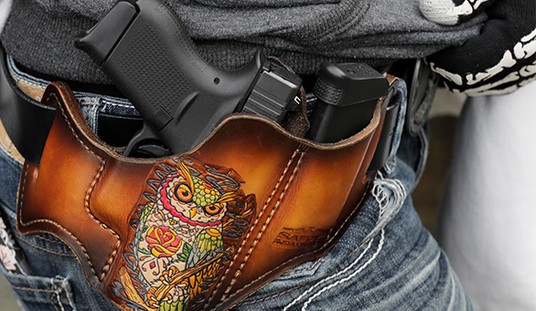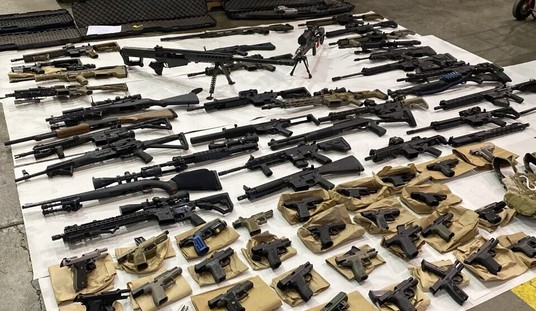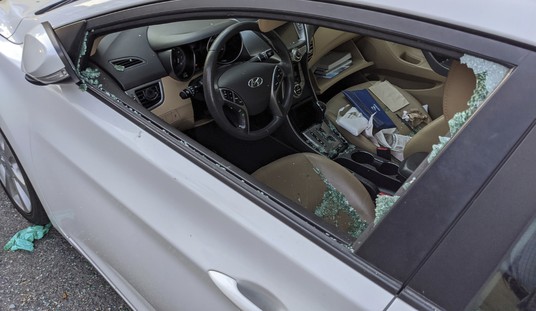[Read Rifle Dynamics AK Builder & Armorer Class, Part 1: Theories and Rivets]

I’m still trying to wipe the smile off my face, and so perhaps I should explain why.
Several months ago I contacted Rifle Dynamics after reading about their AK Builder’s Class. Students start with a bag of parts and a receiver, and leave with a fully function-tested and tuned AK, and perhaps more importantly, an understanding of the design philosophies and the tools and techniques needed to make a quality AKM or AK-74 as the Russians would build them.
We had talked about the philosophy and theory behind the Soviet mindset on the first day of the class, which we discussed in Rifle Dynamics AK Builder & Armorer Class, Part 1: Theories and Rivets. We managed to figure out the basics of riveting, too, as we riveted in our trigger guards.
But as I arrived early to an empty shop Saturday morning, I was beginning to wonder… was I really going to be able to build an AKM in just a day, with no prior knowledge, and do it right?
Our trigger guards set the evening before, our next task was to mount the front trunnion—the part that holds the barrel and everything else on the front end of the gun—into the receiver. We’d start by setting the front trunnion roughly in the receiver and seeing if it was square.
If the trunnion isn’t square in the receiver, you end up with a crooked piece of crap instead of an AKM. The more technical term for that “crooked piece of crap” is a WASR.
First, we fit the trunnion in the receiver and hand-fit the middle two rivets to ensure that the trunnion does indeed fit squarely.

I don’t think any of the students had a receiver/trunnion grossly out of spec, which was yet another benefit of using a good factory-made receiver, instead of trying to build a receiver up from a receiver flat.

From there, we established a cycle I’d call “rivet and chase” (which would be a good name for a talk show).
We’d set a rivet, check to see if the opposite rivet would go in straight, and if it didn’t, we needed to chase (drill out) the hole so that the rivet would fit flush… all while ensuring that the trunnion remained square within the receiver.
It’s the “lather, rinse, repeat” of AK building!

We had two flat rivets that needed to go in on each side, one at a time. The “rivet and chase” process was neat, if a little nerve-wracking in the beginning for those of us not used to A) setting rivets, and B) using a drill press to chase holes. That allowed, I was amazed at how quickly you could develop a feel for when a rivet was properly set. There’s a little bit of Zen involved. Kind of like riding a bike, setting a rivet correctly is a little tricky to learn at first, but when you’ve got it, I suspect that you’ve got it for life.

Once we got the four flat rivets (two on each side) installed, it was time to put in the tricky magwell-side rivets (I think the technical term is “bullet guide rivets,” but don’t quote me on that). These rivets had a bit of a swell in the neck, and the receiver needed to be countersunk/dimpled on a special block so that the trunnion wings don’t collapse. Once again we played “rivet and chase,” and before you know it, all of us had out front trunnions installed, correctly.
The next step was installing the rivets and/or pins that held the rear trunnion. The rear trunnion is the part that holds the receiver to the stock, and like the front trunnion, it needs to be squared up and installed correctly unless you want your stock to be pointing off to one side or the other, all cattywampus. Like the front trunnion, it is a matter of “rivet and chase,” where we’d set a rivet, make sure that the rear trunnion was square in the receiver, and then chase the next rivet hole as needed. The process was different in that we used different jig set-ups and a block so that we could dimple the holes prior to inserting the rivets.
Once the front and rear trunnions were set and we were sure they were all squared up correctly, it was time for the next part of the build, which was installing the barrel.
The very first thing that we did was to smear the outside of the rear of the barrel where it would contact the front trunnion generously with anti-seize. If any of us shot enough rounds through the rifle to burn out the barrel and need a replacement, the anti-seize provided enough lubrication to keep the metal in the trunnion from spalling as it was pressed back out. We then set the barrel roughly in our front trunnions, and attempted to square up the rear sight base, so that the sights would be straight instead of canted when we pressed the barrels into place.
If you look closely at the photo below, you’ll note that there is a thread protector on the muzzle end of the barrel so that the barrel threads aren’t damaged as the barrel is pressed into the front trunnion on the 12-ton press.


In the photo above, you can also see the hole for the barrel pin in the front trunnion, and the cut for the barrel pin cut into the top of the barrel.


One at a time, we used 12-ton presses to push the barrel into the front trunnion. Fine tuning was done with mallet, so that the pin hole in the front trunnion would match up with the cut in the barrel.
Once our barrels were in place and properly aligned, it was time to ensure that the headspacing was correct, using “Go/No Go” gauges.

Once the chambered were verified as being within tolerances, the barrel pin was driven in, and the most difficult part of the build was over. Or was it?

Our trusted AK gurus Billy Cho and Jimmy Fuller were helping students finish up barrel installs, but people started assembling their hand guards, stocks, and other components as soon as they were done. It was “off to the races” for many of them, who were now in a “I know how to do this” zone when it came to installing some parts. I took a lot of notes notes on the order I followed in assembled my AKM, but I know for a fact that it isn’t the only way to proceed from here.

The first thing that I did after sitting back at my work station was to put the parts of the stock together. It was a very straightforward affair of using two long wood screws to attach the trapdoor and buttplate to the rear of the stock. It was so simple, a firearms web site editor could do it.
Installing the rear sling swivel was similarly simple and intuitive.

Logically, I should affix the completed stock to the rear trunnion, right?
Yeah… I didn’t do that.
Instead, I slipped the lower handguard into place, and whacked it with a mallet until the rear was as far in as it would go. The front sling swivel attachment slipped on to the front end of the lower handguard, and there was a locking lever that rotated 180-degrees to lock that into place.
It was about then that the last of the students getting their barrels installs finished, and Billy and Jim corralled us back into a semblance of order.

Billy showed us a very interesting jig that he’d created to enable us to gunsmith our hammers before installing them to achieve optimum function. The Tapco G2 trigger group is a good one for the AK, but the hammer has two “humps” on it that keep the trigger pull from being as smooth as it could be. One by one, we took our turns grinding down these humps so that there was a smooth arc of travel, and then polished them using a rotary tool.

Once the hammer was ground and polished for optimal function, it was time to install the trigger pack. I’d really love to explain the process to you, but Jim decided to use my rifle as a demo on how to install the pack, and so I didn’t get a chance to do it well enough to explain it to you.
Frankly, I’m not all that disappointed is missing this “hands on” experience.
Jim managed to get “snake bit” by slipping hammer springs three times, and the third time drew blood in two shallow wounds that did indeed look like snake bites. Jim also installed the safety, so I missed out on doing that myself, neither of which was a big deal, since there are videos all over the Internet on how to get these two steps done.
Once the trigger pack was in place I went back to installing my stock. I pounded it into the rear trunnion with a mallet, and anchored it in place with two long screws.
The grip went on next.
Then it was a torturous process of forcing the top handguard onto the gas tube and then spinning it 180 degrees until it looked into place.

After that, it was time to install the recoil spring, which is incredibly easy if you have three hands, or your name is Billy Cho.

I got the spring assembly together on the third try, but it took some of the other builders even longer.
Tip: if you aren’t particularly strong and compressing this spring is very easy for you, throw it out and get a new one: your spring is probably worn out.
Assembling the bolt is one of those things that I could talk you through in about a page and maybe explain it in a way that makes sense to everyone. Instead of doing that, I’ll going to simply drop in this video, which also shows you just how brilliantly efficient the buttstock cleaning kit for this rifle really is.
From here, it’s a relatively simple matter of putting the bolt into the bolt carrier and sending it home in the upper receiver, and then putting the spring assembly into the gun and cycling it to make sure it works. If everything cycles as it should you slip the front of the top cover into place (there’s a notch for it) and then slam it home.

You now have a functional AKM… not just one that you can aim. We still have the front and rear sights to mount!
The front sight simple screws in using a tool in your buttstock cleaning kit, but it is an absolute bear to get started. Once you do, it simply threads in place. I think that the front sight detent and spring were already installed in my rifle when I got my parts kit.
The rear sight assembly snaps into place once your rear sight leaf spring is in place to provide the proper tension. A bonus of building an AKM with Rifle Dynamics is that the rear sight on our rifles were already tricked out with the Fuller AK Rear Sight Mod.

At this point the rifle was almost done. We only had two things left to do.
The first was swapping out the muzzle protector and replacing it with the slant brake. This was a simple matter of playing “Leftie tighty/righty loosey.” Did I mention that the Russians thread their barrels opposite of the way we do?
The second was putting in a small dimple for the safety to catch in, on the right side of the rifle. This would help keep the safety from inching back up under rapid fire.

And then, incredibly, we were done. We went from a bag of parts and a receiver with just the trigger guard installed to a perfectly built and finished AKM (or AK-74) in just the course of a day.
A student asked Jim how much a rifle built to this level of quality would go for on the open market. He didn’t have to guess as an answer. In the two years he’s be doing these builder & armorer courses, several students have opted to sell their rifles online.

One sold for $1,100 dollars. Other have sold in the $1,000 range. He was quite confident that each of our rock-solid rifles was worth $1,000, and could last for several hundred thousand rounds with the occasional spring, trigger group, and barrel replacement.
If I remember correctly, Jim had to change out trigger groups several times on his personal full-auto AKS-74U, the barrel after he shot it into a smoothbore after 60,000 rounds fired mostly full auto, and may be due for another barrel replacement soon since he’s now over 120,000 rounds.
It was near the end of the day, but we’d all completed our rifles with time to spare, without any significant problems thanks to instructors that ensured that we never got too far off track.
The next day would be the real test, when we took these rifles to the range.
You see, they were completely dry, without a drop of lubrication in them.
Our first task on the firing line would be to do a “burn in,” firing a 30-round magazine in these dry rifles just as fast as we could squeeze the trigger. It was here that we expected to discover if our rifles passed, or failed.
I could hardly wait to see how my rifle would function, but unfortunately, I’d have to wait until the following morning.
We’ll tell you how that went—and why my rifle has a slight bacon odor—in part 3 of the series.
[Read Rifle Dynamics AK Builder & Armorer Class, Part 1: Theories and Rivets]








Join the conversation as a VIP Member